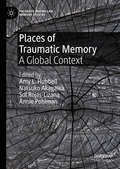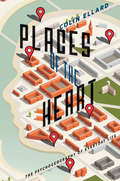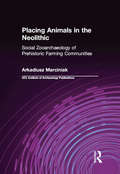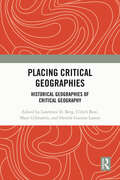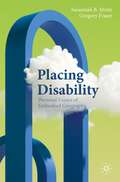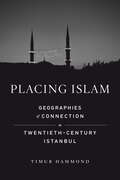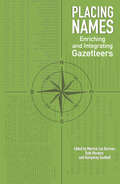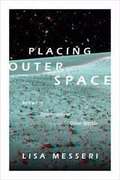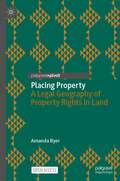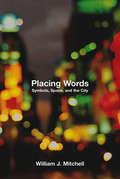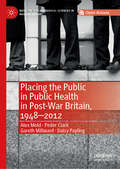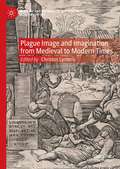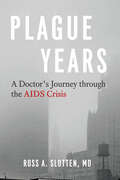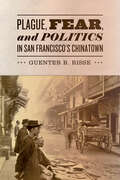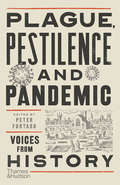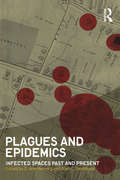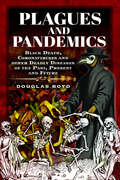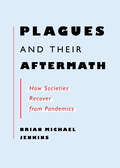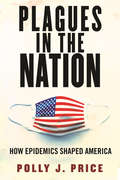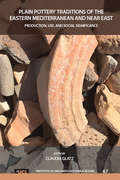- Table View
- List View
Places of Traumatic Memory: A Global Context (Palgrave Macmillan Memory Studies)
by Annie Pohlman Amy L. Hubbell Natsuko Akagawa Sol Rojas-LizanaThis volume explores the relationship between place, traumatic memory, and narrative. Drawing on cases from Africa, Asia, Europe, Oceania, and North and South America, the book provides a uniquely cross-cultural and global approach. Covering a wide range of cultural and linguistic contexts, the volume is divided into three parts: memorial spaces, sites of trauma, and traumatic representations. The contributions explore how acknowledgement of past suffering is key to the complex inter-relationship between the politics of memory, expressions of victimhood, and collective memory. Contributors take note of differing aspects of memorial culture, such as those embedded in war memorials, mass grave sites, and exhibitions, as well as journalistic, literary and visual forms of commemorations, to investigate how narratives of memory can give meaning and form to places of trauma.
Places of the Heart
by Colin EllardA Selection of the Library of Science, History, and Military Book Clubs"One of the finest science writers I've ever read." -Los Angeles Times"Ellard has a knack for distilling obscure scientific theories into practical wisdom." -New York Times Book Review"[Ellard] mak[es] even the most mundane entomological experiment or exegesis of psychological geekspeak feel fresh and fascinating." -NPR"Colin Ellard is one of the world's foremost thinkers on the neuroscience of urban design. Here he offers an entirely new way to understand our cities-and ourselves." -CHARLES MONTGOMERY, author of Happy City: Transforming Our Lives Through Urban DesignOur surroundings can powerfully affect our thoughts, emotions, and physical responses, whether we're awed by the Grand Canyon or Hagia Sophia, panicked in a crowded room, soothed by a walk in the park, or tempted in casinos and shopping malls. In Places of the Heart, Colin Ellard explores how our homes, workplaces, cities, and nature-places we escape to and can't escape from-have influenced us throughout history, and how our brains and bodies respond to different types of real and virtual space. As he describes the insight he and other scientists have gained from new technologies, he assesses the influence these technologies will have on our evolving environment and asks what kind of world we are, and should be, creating.Colin Ellard is the author of You Are Here: Why We Can Find Our Way to the Moon, but Get Lost in the Mall. A cognitive neuroscientist at the University of Waterloo and director of its Urban Realities Laboratory, he lives in Kitchener, Ontario.
Placing Animals in the Neolithic: Social Zooarchaeology of Prehistoric Farming Communities (UCL Institute of Archaeology Publications)
by Arkadiusz MarciniakThis book presents a new perspective on the social milieu of the Early and Middle Neolithic in Central Europe as viewed through relations between humans and animals, food acquisition and consumption, as well as refuse disposal practices. Based on animal bone assemblages from a wide range of sites from a period of over 2,000 years originating in both the North European Plain lowlands and the loess uplands, the evidence explored in the book represents the Linear Band Pottery Culture (LBK), the Lengyel Culture, and the Funnel Beaker Culture (TRB) allowing us to follow the dynamic development of early farmers from their emergence in the area north of the Carpathians up to their consolidation and stabilization in this new territory.
Placing Critical Geography: Historical Geographies of Critical Geography
by Mary Gilmartin Henrik Gutzon Larsen Lawrence D. Berg Ulrich BestThis book explores the multiple histories of critical geography as it developed in 14 different locations around the globe, whilst bringing together a range of approaches in critical geography. It is the first attempt to provide a comprehensive account of a wide variety of historical geographies of critical geography from around the world. Accordingly, the chapters provide accounts of the development of critical approaches in geography from beyond the hegemonic Anglo-American metropoles. Bringing together geographers from a wide range of regional and intellectual milieus, this volume provides a critical overview that is international and illustrates the interactions (or lack thereof) between different critical geographers, working across a range of spaces. The chapters provide a more nuanced history of critical geography, suggesting that while there were sometimes strong connections with Anglo-American critical geography, there were also deeply independent developments that were part of the construction of very different kinds of critical geography in different parts of the world. Placing Critical Geographies provides an excellent companion to existing histories of critical geography and will be important reading for researchers as well as undergraduate and graduate students of the history and philosophy of geography.
Placing Disability: Personal Essays of Embodied Geography (Literary Disability Studies)
by Susannah B. Mintz Gregory FraserPlacing Disability presents an international collection of personal essays that address the experience of disability in particular geographical locations. Each chapter engages the question of what it means to be disabled in a specific place, exploring issues of movement, work and play, community and activism, artistic production, love and marriage, access and social services, family and friendship, memory and aging—all informed by the places that people inhabit. The book is organized in terms of topographies and vistas, rather than being bound by the map, to emphasize the defining, constitutive effects of place. The authors included in Placing Disability hail from different countries, neighborhoods, climates, and landscapes; from various backgrounds and professions; from a range of disciplinary perspectives and strategies. They are trained as academics, literary critics, poets, students, public speakers, memoirists, educators, philosophers, administrators, and activists. Their essays refine our understanding of the complex dynamic between self and circumstance as they survey the impact of geographical region on their life experiences. This book is intended to be useful in creative-writing workshops, Disability Studies seminars, and classes on environmental literature, and to appeal to general readers of memoir as well as to scholars of contemporary body theory or the Anthropocene.
Placing Islam: Geographies of Connection in Twentieth-Century Istanbul (Islamic Humanities #4)
by Timur Warner HammondA free ebook version of this title is available through Luminos, University of California Press’s Open Access publishing program. Visit www.luminosoa.org to learn more. For centuries, the Mosque of Eyüp Sultan has been one of Istanbul’s most important pilgrimage destinations, in large part because of the figure buried in the tomb at its center: Halid bin Zeyd Ebû Eyûb el-Ensârî, a Companion of the Prophet Muhammad. Timur Hammond argues here, however, that making a geography of Islam involves considerably more. Following practices of storytelling and building projects from the final years of the Ottoman Empire to the early 2010s, Placing Islam shows how different individuals and groups articulated connections among people, places, traditions, and histories to make a place that is paradoxically defined by both powerful continuities and dynamic relationships to the city and wider world. This book provides a rich account of urban religion in Istanbul, offering a key opportunity to reconsider how we understand the changing cultures of Islam in Turkey and beyond.
Placing Names: Enriching and Integrating Gazetteers
by Merrick Lex Berman, Ruth Mostern, and Humphrey SouthallWell before the innovation of maps, gazetteers served as the main geographic referencing system for hundreds of years. Consisting of a specialized index of place names, gazetteers traditionally linked descriptive elements with topographic features and coordinates. Placing Names is inspired by that tradition of discursive place-making and by contemporary approaches to digital data management that have revived the gazetteer and guided its development in recent decades. Adopted by researchers in the Digital Humanities and Spatial Sciences, gazetteers provide a way to model the kind of complex cultural, vernacular, and perspectival ideas of place that can be located in texts and expanded into an interconnected framework of naming history. This volume brings together leading and emergent scholars to examine the history of the gazetteer, its important role in geographic information science, and its use to further the reach and impact of spatial reasoning into the digital age.
Placing Outer Space: An Earthly Ethnography of Other Worlds
by Lisa MesseriIn Placing Outer Space Lisa Messeri traces how the place-making practices of planetary scientists transform the void of space into a cosmos filled with worlds that can be known and explored. Making planets into places is central to the daily practices and professional identities of the astronomers, geologists, and computer scientists Messeri studies. She takes readers to the Mars Desert Research Station and a NASA research center to discuss ways scientists experience and map Mars. At a Chilean observatory and in MIT's labs she describes how they discover exoplanets and envision what it would be like to inhabit them. Today's planetary science reveals the universe as densely inhabited by evocative worlds, which in turn tells us more about Earth, ourselves, and our place in the universe.
Placing Property: A Legal Geography of Property Rights in Land (Palgrave Socio-Legal Studies)
by Amanda ByerThis open access book presents a legal geography of property rights in land through the lenses of landscape and critical spatial justice. It seeks to reassert the importance of landscape and place in property as an alternative to abstract concepts of property which dominate contemporary thinking. It investigates property’s origins and uptake in the common law through the lenses of landscape and spatial justice, providing a genealogy of property, from its early origins in pre-feudal Scandinavia to its development as a cornerstone concept in English common law. It offers a new perspective and analytical tools to reconsider many accepted approaches to land in the law today. This book also contributes both to the decolonization of property law and critiques of property’s unsustainability, as well as the examination of the role of law itself in facilitating large scale land changes that destroy place, and the ramifications of this process. As such, it should be of interest to inter-disciplinary scholars working in the socio-legal, environmental and property law fields
Placing Words: Symbols, Space, and the City (The\mit Press Ser.)
by William J. MitchellReflections on architecture and the exchange of information in the spaces and places of the city, from the necessity of skyscrapers in an age of Web sites to cities as talent magnets, from architectural bling to the neo-minimalism of the new MoMA.The meaning of a message, says William Mitchell, depends on the context of its reception. "Shouting 'fire' in a crowded theater produces a dramatically different effect from barking the same word to a squad of soldiers with guns," he observes. In Placing Words, Mitchell looks at the ways in which urban spaces and places provide settings for communication and at how they conduct complex flows of information through the twenty-first century city.Cities participate in the production of meaning by providing places populated with objects for words to refer to. Inscriptions on these objects (labels, billboards, newspapers, graffiti) provide another layer of meaning. And today, the flow of digital information—from one device to another in the urban scene—creates a digital network that also exists in physical space. Placing Words examines this emerging system of spaces, flows, and practices in a series of short essays—snapshots of the city in the twenty-first century.Mitchell questions the necessity of flashy downtown office towers in an age of corporate Web sites. He casts the shocked-and-awed Baghdad as a contemporary Guernica. He describes architectural makeovers throughout history, listing Le Corbusier's Fab Five Points of difference between new and old architecture, and he discusses the architecture of Manolo Blahniks. He pens an open letter to the Secretary of Defense recommending architectural features to include in torture chambers. He compares Baudelaire, the Parisian flaneur, to Spiderman, the Manhattan traceur. He describes the iPod-like galleries of the renovated MoMA and he recognizes the camera phone as the latest step in a process of image mobilization that began when artists stopped painting on walls and began making pictures on small pieces of wood, canvas, or paper. The endless flow of information, he makes clear, is not only more pervasive and efficient than ever, it is also generating new cultural complexities.
Placing the Future (Knowledge and Space #20)
by Johannes Glückler Matthias Garschagen Robert PanitzThis open access book offers a fresh perspective on the uncertainties of the future that humanity faces. Leading scholars from the fields of future studies, planning, geography, history, sociology, design, and the humanities sensitize for the intricate role of geography in building knowledge to anticipate probable, to imagine alternative, and to enact desirable futures. Part I, knowing the future, explores strategies for anticipating possible futures, such as foresight methods, scenarios, and guiding images. This section underscores the importance of cultivating future consciousness to confront societal denial of looming threats like environmental crises. Part II, envisioning the future, delves into various ways societies imagine their futures, exploring topics like the future of food, post-growth economies, extra-terrestrial futures, and even human self-extinction to reveal how futurist scenarios can inform decision making and proactive planning. Part III, enacting the future, focuses on the performative aspects of futuring. The authors in this section examine practices—such as designing, performing, advising, and governing—that are aimed at transforming desired futures into present realities. As part of a series on the interdisciplinary nexus between knowledge and space, this book is an essential resource for researchers, policy makers, planners, students, and practitioners in the fields of sustainability, future studies, regional development, and governance.
Placing the Public in Public Health in Post-War Britain, 1948–2012 (Medicine and Biomedical Sciences in Modern History)
by Alex Mold Gareth Millward Peder Clark Daisy PaylingThis open access book explores the question of who or what ‘the public’ is within ‘public health’ in post-war Britain. Drawing on historical research on the place of the public in public health in Britain from the establishment of the National Health Service in 1948, the book presents a new perspective on the relationship between state and citizen. Focusing on health education, health surveys, heart disease and the development of vaccination policy and practice, the book establishes that ‘the public’ was not one thing but many. It considers how public health policy makers and practitioners imagined the public or publics. These publics were not mere constructions; they had agency and the ability to ‘speak back’ to public health. The nature of publicness changed during the latter half of the twentieth century, and this book argues that the relationship between the public and public health offers a powerful lens through which to examine such shifts.
Plague Image and Imagination from Medieval to Modern Times (Medicine and Biomedical Sciences in Modern History)
by Christos LynterisThis edited collection brings together new research by world-leading historians and anthropologists to examine the interaction between images of plague in different temporal and spatial contexts, and the imagination of the disease from the Middle Ages to today. The chapters in this book illuminate to what extent the image of plague has not simply reflected, but also impacted the way in which the disease is experienced in different historical periods. The book asks what is the contribution of the entanglement between epidemic image and imagination to the persistence of plague as a category of human suffering across so many centuries, in spite of profound shifts in our medical understanding of the disease. What is it that makes plague such a visually charismatic subject? And why is the medical, religious and lay imagination of plague so consistently determined by the visual register? In answering these questions, this volume takes the study of plague images beyond its usual, art-historical framework, so as to examine them and their relation to the imagination of plague from medical, historical, visual anthropological, and postcolonial perspectives.
Plague Years: A Doctor’s Journey through the AIDS Crisis
by Ross A. Slotten, MDIn 1992, Dr. Ross A. Slotten signed more death certificates in Chicago—and, by inference, the state of Illinois—than anyone else. As a family physician, he was trained to care for patients from birth to death, but when he completed his residency in 1984, he had no idea that many of his future patients would be cut down in the prime of their lives. Among those patients were friends, colleagues, and lovers, shunned by most of the medical community because they were gay and HIV positive. Slotten wasn’t an infectious disease specialist, but because of his unique position as both a gay man and a young physician, he became an unlikely pioneer, swept up in one of the worst epidemics in modern history. Plague Years is an unprecedented first-person account of that epidemic, spanning not just the city of Chicago but four continents as well. Slotten provides an intimate yet comprehensive view of the disease’s spread alongside heartfelt portraits of his patients and his own conflicted feelings as a medical professional, drawn from more than thirty years of personal notebooks. In telling the story of someone who was as much a potential patient as a doctor, Plague Years sheds light on the darkest hours in the history of the LGBT community in ways that no previous medical memoir has.
Plague, Fear, and Politics in San Francisco's Chinatown
by Guenter B. RisseWhen health officials in San Francisco discovered bubonic plague in their city’s Chinatown in 1900, they responded with intrusive, controlling, and arbitrary measures that touched off a sociocultural conflict still relevant today. Guenter B. Risse’s history of an epidemic is the first to incorporate the voices of those living in Chinatown at the time, including the desperately ill Wong Chut King, believed to be the first person infected.Lasting until 1904, the plague in San Francisco's Chinatown reignited racial prejudices, renewed efforts to remove the Chinese from their district, and created new tensions among local, state, and federal public health officials quarreling over the presence of the deadly disease. Risse's rich, nuanced narrative of the event draws from a variety of sources, including Chinese-language reports and accounts. He addresses the ecology of Chinatown, the approaches taken by Chinese and Western medical practitioners, and the effects of quarantine plans on Chinatown and its residents. Risse explains how plague threatened California’s agricultural economy and San Francisco’s leading commercial role with Asia, discusses why it brought on a wave of fear mongering that drove perceptions and intervention efforts, and describes how Chinese residents organized and successfully opposed government quarantines and evacuation plans in federal court. By probing public health interventions in the setting of one of the most visible ethnic communities in United States history, Plague, Fear, and Politics in San Francisco’s Chinatown offers insight into the clash of Eastern and Western cultures in a time of medical emergency.
Plague, Pestilence and Pandemic: Voices From History
by Peter FurtadoAn eye-opening anthology from the bestselling editor of Histories of Nations, exploring how people around the globe have suffered and survived during plague and pandemic, from the ancient world to the present. Plague, pestilence, and pandemics have been a part of the human story from the beginning and have been reflected in art and writing at every turn. Humankind has always struggled with illness; and the experiences of different cities and countries have been compared and connected for thousands of years. Many great authors have published their eyewitness accounts and survivor stories of the great contagions of the past. When the great Muslim traveler Ibn Battuta visited Damascus in 1348 during the great plague, which went on to kill half of the population, he wrote about everything he saw. He reported, "God lightened their affliction; for the number of deaths in a single day at Damascus did not attain 2,000, while in Cairo it reached the figure of 24,000 a day." From the plagues of ancient Egypt recorded in Genesis to those like the Black Death that ravaged Europe in the Middle Ages, and from the Spanish flu of 1918 to the Covid-19 pandemic in our own century, this anthology contains fascinating accounts. Editor Peter Furtado places the human experience at the center of these stories, understanding that the way people have responded to disease crises over the centuries holds up a mirror to our own actions and experiences. Plague, Pestilence and Pandemic includes writing from around the world and highlights the shared emotional responses to pandemics: from rage, despair, dark humor, and heartbreak, to finally, hope that it may all be over. By connecting these moments in history, this book places our own reactions to the Covid-19 pandemic within the longer human story.
Plague-Making and the AIDS
by Gina M. BrightCaptures the social, political, and medical discrimination experienced by people with AIDS in the US, which has resulted from our culture's construction of the disease as a plague.
Plague: A Story of Science, Rivalry, and the Scourge That Won't Go Away
by Edward MarriottA riveting account, at once a reconstruction of the race to find a cure, a history of bubonic plague, and an investigation into the threat of plague today Plague. The very word carries an unholy resonance. No other disease can claim its apocalyptic or mythological power. It can lie dormant for centuries, only to resurface with ferocious, nation-killing force. Here, with the high drama of a great adventure tale, Edward Marriott unravels the story of this lethal disease: the historic battle to identify its source, the devastating effects of pandemics, and the prospects for the next outbreak.Through a range of primary sources, Marriott takes us back to Hong Kong in the summer of 1894, when a diagnosis of plague brought two top scientists to the island-Alexandre Yersin, a lone, maverick Frenchman, and his eminent rival, the Japanese Shibasaburo Kitasato. Marriott interweaves his narrative of their fierce competition to discover the plague's source with vivid scenes of the scourge's persistence: California in 1900, when plague arrived in the United States; Surat, India, in 1994, where torrential floods drowned millions of rats, causing the worst epidemic in seventy years; and New York City, some time in the future, where there is a rat for every human being, a diminishing budget for pest control, and an emerging strain of plague that is resistant to antibiotics.A masterly recounting of medical and human history, Plague is an instructive warning, a gripping account of history, and a chilling read.
Plagues and Epidemics: Infected Spaces Past and Present (Wenner-Gren International Symposium Series)
by D. Ann HerringUntil recently, plagues were thought to belong in the ancient past. Now there are deep worries about global pandemics. This book presents views from anthropology about this much publicized and complex problem. The authors take us to places where epidemics are erupting, waning, or gone, and to other places where they have not yet arrived, but where a frightening story line is already in place. They explore public health bureaucracies and political arenas where the power lies to make decisions about what is, and is not, an epidemic. They look back into global history to uncover disease trends and look ahead to a future of expanding plagues within the context of climate change. The chapters are written from a range of perspectives, from the science of modeling epidemics to the social science of understanding them. Patterns emerge when people are engulfed by diseases labeled as epidemics but which have the hallmarks of plague. There are cycles of shame and blame, stigma, isolation of the sick, fear of contagion, and end-of-the-world scenarios. Plague, it would seem, is still among us.
Plagues and Pandemics: Black Death, Coronaviruses and Other Deadly Diseases of the Past, Present and Future
by Douglas BoydAn overview of deadly diseases from throughout world history spanning from prehistoric civilizations to the twenty-first century.All you need for a plague to go pandemic are population clusters and travelers spreading the bacterial or viral pathogens. Many prehistoric civilizations died fast, leaving cities undamaged to mystify archeologists. Plague in Athens killed 30% of the population 430–426 BCE. When Roman Emperor Justinian I caught bubonic plague in 541 CE, contemporary historian Procopius described his symptoms: fever, delirium and buboes—large black swellings of the lymphatic glands in the groin, under the arms and behind the ears. That bubonic plague killed twenty-five million people around the Mediterranean. Later dubbed Black Death, it killed fifty million people 1346-1353, returning to London forty times in the next 300 years. The third bubonic plague pandemic started 1894 in China, claiming fifteen million lives, largely in Asia, before dying down in the 1950s after visiting San Francisco and New York. But it also hit Madagascar in 2014, and the Congo and Peru. The cause, yersinia pestis was identified in 1894. Infected fleas from rats on merchant ships were blamed for spreading it, but Porton Down scientists have a worrying explanation why the plague spread so fast.Any disease can go epidemic. Everyday European infections brought to the Americas by Cortes’ conquistadores killed millions of the natives, whose posthumous revenge was the syphilis the Spaniards brought back to Europe. The mis-named Spanish flu, brought from Kansas to Europe by U.S. troops in 1918 caused more than fifty million deaths. Fifty years later, H3N2 flu from Hong Kong killed more than a million people.One coronavirus produces the common cold, for which neither vaccine nor cure has been found, despite the loss of millions of working days each year. Chillingly, historian Douglas Boyd lists many other sub-microscopic killers still waiting for tourism and trade to bring them to us.
Plagues and Their Aftermath: How Societies Recover from Pandemics
by Brian Michael JenkinsA look at the long history of epidemics and pandemics provides an enthralling account of what we can expect of a post-COVID worldIn a concise, authoritative, and gripping telling, Brian Michael Jenkins — one of our leading authorities on national security and an advisor to governments, presidents and CEOs — provides a masterly account of what kind of future the planet might be facing ... by looking at the world's long history of epidemics and discerning what was common about their aftermath. From a plague in Athens during the Peloponnesian War in 430 BCE, to another in 540 that wiped out half the population of the Roman empire, down through the Black Death in the Middle Ages and on through the 1918 flu epidemic (which killed between 50 and 100 million people) and this century's deadly SARS outbreak, plagues have been a much more relentless fact of life than many realize. The legacy of epidemics, Jenkins observes, is not only one of lives lost but of devastated economies and social disorder, all of which have severe political repercussions. Thus, each chapter of Plagues and Their Aftermath draws on those historical precursors to focus on one particular aspect of their aftermath: What happens to political systems? What happens in the area of crime and terrorism? Do wars happen? What are the effects on cultures? What was the impact of widespread fear and public hysteria, of increased suspicion and scapegoating, of the spread of rumors and conspiracy theories? Jenkins' sobering analysis is riveting and thought-provoking reading for general readers and specialists alike, and throws welcome light into what many fear is a dark future.
Plagues in the Nation: How Epidemics Shaped America
by Polly J. PriceSheds light on the US government&’s response to epidemics through history—with larger conclusions about COVID-19 and reforms needed before the next plague.In this narrative history of the US through major outbreaks of contagious disease, from yellow fever to the Spanish flu, from HIV/AIDS to Ebola, Polly J. Price examines how law and government affected the outcome of epidemics—and how those outbreaks in turn shaped our government. Price presents a fascinating history that has never been fully explored and draws larger conclusions about the gaps in our governmental and legal response. Plagues in the Nation examines how our country learned—and failed to learn—how to address the panic, conflict, and chaos that are the companions of contagion, what policies failed America again and again, and what we must do better next time.
Plagues upon the Earth: Disease and the Course of Human History (The Princeton Economic History of the Western World #106)
by Kyle HarperA sweeping germ’s-eye view of history from human origins to global pandemicsPlagues upon the Earth is a monumental history of humans and their germs. Weaving together a grand narrative of global history with insights from cutting-edge genetics, Kyle Harper explains why humanity’s uniquely dangerous disease pool is rooted deep in our evolutionary past, and why its growth is accelerated by technological progress. He shows that the story of disease is entangled with the history of slavery, colonialism, and capitalism, and reveals the enduring effects of historical plagues in patterns of wealth, health, power, and inequality. He also tells the story of humanity’s escape from infectious disease—a triumph that makes life as we know it possible, yet destabilizes the environment and fosters new diseases.Panoramic in scope, Plagues upon the Earth traces the role of disease in the transition to farming, the spread of cities, the advance of transportation, and the stupendous increase in human population. Harper offers a new interpretation of humanity’s path to control over infectious disease—one where rising evolutionary threats constantly push back against human progress, and where the devastating effects of modernization contribute to the great divergence between societies. The book reminds us that human health is globally interdependent—and inseparable from the well-being of the planet itself.Putting the COVID-19 pandemic in perspective, Plagues upon the Earth tells the story of how we got here as a species, and it may help us decide where we want to go.
Plain Diversity: Amish Cultures and Identities (Young Center Books in Anabaptist and Pietist Studies)
by Steven M. Nolt Thomas J. MeyersPlain and simple. American popular culture has embraced a singular image of Amish culture that is immune to the complexities of the modern world: one-room school houses, horses and buggies, sound and simple morals, and unfaltering faith. But these stereotypes dangerously oversimplify a rich and diverse culture.In fact, contemporary Amish settlements represent a mosaic of practice and conviction. In the first book to describe the complexity of Amish cultural identity, Steven M. Nolt and Thomas J. Meyers explore the interaction of migration history, church discipline, and ethnicity in the community life of nineteen Amish settlements in Indiana. Their extensive field research reveals the factors that influence the distinct and differing Amish identities found in each settlement and how those factors relate to the broad spectrum of Amish settlements throughout North America. Nolt and Meyers find Amish children who attend public schools, Amish household heads who work at luxury mobile home factories, and Amish women who prefer a Wal-Mart shopping cart to a quilting frame. Challenging the plain and simple view of Amish identity, this study raises the intriguing question of how such a diverse people successfully share a common identity in the absence of uniformity.
Plain Pottery Traditions of the Eastern Mediterranean and Near East: Production, Use, and Social Significance (UCL Institute of Archaeology Publications #67)
by Claudia GlatzThe evolution and proliferation of plain and predominantly wheel-made pottery presents a characteristic feature of the societies of the Near East and Eastern Mediterranean since the fourth millennium B.C. This plain pottery has received little detailed archaeological attention in comparison to aesthetically more pleasing and chronologically sensitive decorated traditions. Yet, their simplicity and standardization suggest they are products of craft specialists, the result of high-volume production, and therefore important in understanding the social systems in early complex societies. This volume-reevaluates the role and significance of plain pottery traditions from both historically specific perspectives and from a comparative point of view;-examines the uses and functions of this pottery in relation to social negotiation and group identity formation;-helps scholars understand cross-regional similarities in development and use.
